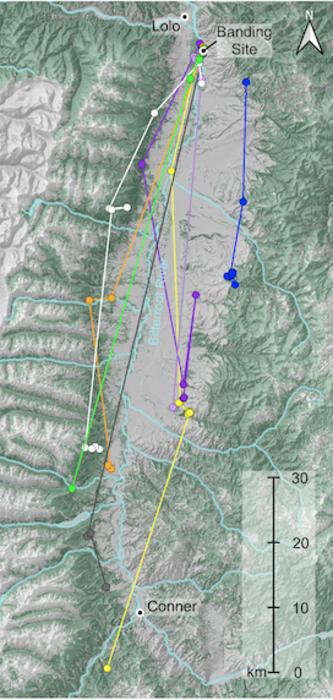In recent research that shines a light on the elusive Northern Saw-whet Owl, scientists have unveiled intricate details surrounding the migratory behaviors and stopover patterns of this small, enigmatic species. Conducted over the fall migration periods of 2014 and 2015, the study involved tracking 89 of these owls in the Bitterroot Valley of western Montana. By utilizing advanced telemetry technology, the team was able to observe individual movements and reveal unexpected findings regarding the owls’ migratory strategies.
The Northern Saw-whet Owl, known scientifically as Aegolius acadicus, has long been a subject of interest for ornithologists due to its cryptic nature. The species is not only one of the smallest owls in North America but also notoriously difficult to spot during migration. In this groundbreaking study, researchers implemented a methodology that involved the use of temporary VHF radio transmitters, allowing them to monitor the birds’ movements across varying terrains more accurately than traditional methods, such as banding.
In total, the research team tracked a majority of recently fledged female owls, focusing on their nightly travel distances, which varied significantly. While some owls averaged between three to eight kilometers per night, others traveled much greater distances, with one owl recorded journeys of nearly 66 kilometers in a single night. This variability highlights the importance of habitat and environmental factors influencing individual owl behaviors, particularly as they navigate between roosting sites and migratory destinations.
The researchers were initially surprised by the variability in migration routes as well. Many of the tracked owls did not follow a direct southward path, illustrating the potential for diverse migratory strategies influenced by personal experience or external environmental factors. Furthermore, data from the study indicates that over half of the owls paused at various points during their migration, emphasizing the critical need for safe resting areas along migratory routes.
The authors of the study, led by Kate Stone, express hope that this information can ignite further research into the migration patterns of other less-studied owl species. Understanding the unique ecological needs of the common Saw-whet Owl may facilitate better management practices not just for this species but for others that are at greater risk due to habitat loss and environmental change.
Telemetric studies like this are essential not only due to their innovative data-gathering techniques but also for their potential to adapt and evolve in future research endeavors. Stone mentioned the possibility of employing longer-lasting tracking devices in conjunction with automated systems, such as the Motus wildlife tracking system, which could provide even more comprehensive insights into owl movements.
In conclusion, the Northern Saw-whet Owl’s migration story, now revealed in unprecedented detail, offers vital insights into the life of this diminutive raptor. As researchers continue to study this elusive species, each finding contributes to a broader dialogue surrounding conservation efforts aimed at safeguarding the future of owls and birds throughout North America.
Subject of Research: Animals
Article Title: Migration and Roosting Behavior of Northern Saw-whet Owls (Aegolius acadicus) During Fall Migration in Western Montana
News Publication Date: 18-Mar-2025
Web References: http://dx.doi.org/10.3356/jrr2432
References: Stone, K., & Ramsey, P. (2025). Migration and Roosting Behavior of Northern Saw-whet Owls (Aegolius acadicus) During Fall Migration in Western Montana. Journal of Raptor Research, 59(2): 1-11. DOI: 10.3356/jrr2432
Image Credits: Stone and Ramsey.
Keywords: Northern Saw-whet Owl, migration, telemetry, conservation, ornithology, habitat, behavior.
Tags: advanced methods in wildlife researchAegolius acadicus migration strategiesBitterroot Valley avian studiescryptic nature of Northern Saw-whet Owlsmigratory behaviors of owlsNorthern Saw-whet Owl migration patternsornithological findings on migrationsmall owl species migration studystopover behavior in migratory owlstelemetry technology in bird trackingVHF radio transmitters in wildlife trackingWestern Montana ornithology research






